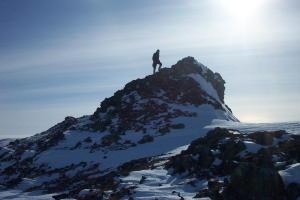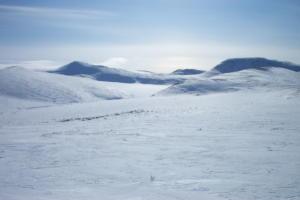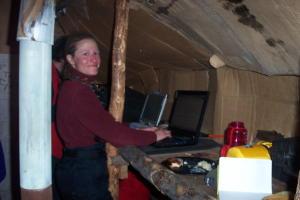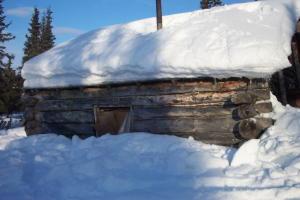27 March, 2002
When the morning starts off with a blessed
sighting of caribou on the bare brown tundra, the
Arctic is telling you the day will be one plucked
from your dreams. We crossed through the
splendid, steep Darby mountains. The brown
tundra was not covered with snow for a majority
of the travel. This is due to some unusual
weather patterns occurring within the mountains.
We bumped and jostled along on our snowmachines
looking for snow. We traveled down a mountain
and up to the top of another and then our eyes
were taken to the herd of caribou. The caribou
were grazing, ambling around, eating and moving….
this brown tundra was their safe haven from the
snow. We stopped and Eric plowed ahead to find
the best path to maneuver through the mountains.
He returned and we traveled on up and down steep
snow covered mountains. A dream of sun and snow
that captivates, intrigues the mind. I cannot
help but comparing our expedition to a small
degree to the famous Lewis and Clark expedition.
SWE... You know me... Hey, Hey... Yes still rapping
the SWE tune!!!!
SWE stands for snow water equivalence. This
measurement tells us how much of the snow is
actually water. The other component is air. We
can get the snow water equivalence by calculating
density.
Density, once again, is the mass per unit volume.
Simply stated this is the amount of matter in a
given amount of space. The more dense a
substance is the more matter that is tightly
packed into that area. The less dense a
substance is the less amount of matter is packed
into that given space. A good example is to
think of the crowded hallway during class change.
The density of students would be high. A low
density of students would be if there were only
three students in a classroom. Get the idea???
Now, let's look at the density of snow and water.
The known density of water is 1.0 g/ml or 1.0
g/cm^3.
Anything with a density greater than 1.0 g/ml
sinks in water. Anything with a density less
than 1.0 g/ml floats in water. Snow has
different densities depending on the air to
volume ratio. So, how do we find the density of
the snow out here in the remote wilderness??????
First we have to do some math, remember the
sweetest tube from yesterday? It was shaped as a
cylinder.
The diameter of the tube is 3.82 cm.
From this you can calculate the area of the tube.
A = pie r^2.
A = 3.14 radius ^2
We also take the depth of the snow at the SWE
site. So by multiplying the
depth X area = volume
So here is your homework: From these snow
depths, calculate the volume of snow:
DEPTH OF SNOW:
1) 44 cm
2) 28 cm
3) 51 cm
4) 40 cm
5) 44 cm
These snow depths were recorded on the tundra
where there is less snow due to the wind. The
forest sites have snow depth up to 70 cm!!!!!!!
Tomorrow... Calculate density!
SO WHERE IS MRS. CHEUVRONT??? LET'S PLOT!!!
65.1931 degrees north
162.27603 degrees west
Camp tonight is luxurious!! We are at Camp Haven
which has an old abandoned log cabin. The walls
are insulated with cardboard and the windows are
uncovered. It's cozy and nice to be out of the
tent for an evening. These accommodations are
allowing me to email journals!!

On the snowmachine to the next sample site!

Jon scaling a mountain! Looking onward!

Traveling through the Darby mountains.

Inside the cabin at Camp Haven! Notice the cardboard insulation. We are living it up!!!

Hotel Camp Haven!!!
Contact the TEA in the field at
.
If you cannot connect through your browser, copy the
TEA's e-mail address in the "To:" line of
your favorite e-mail package.
|
